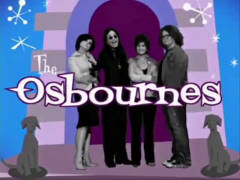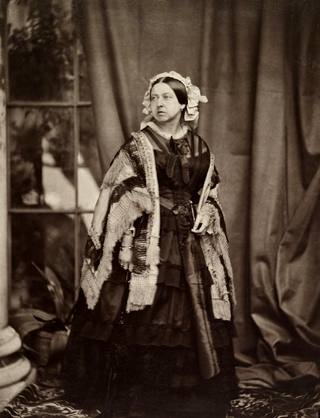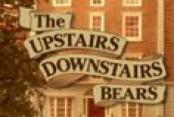
The Osbournes is an American reality television program featuring the domestic life of heavy metal singer Ozzy Osbourne and his family—his wife Sharon, their daughter Kelly, and their son Jack. The series premiered on MTV on March 5, 2002, and, in its first season, was cited as the most-viewed series ever on MTV. The final episode aired on March 21, 2005.
The Adam and Joe Show is a British television comedy show, written and presented by Adam and Joe, which ran for 22 episodes and four series on Channel 4 from 6 December 1996 to 16 May 2001. All four series are available free to watch on All 4, but currently only a compilation of the best of the entire run is available on DVD. However all episodes are available on iTunes.

Bravo is an American basic cable television network, launched on December 8, 1980. It is owned by the NBCUniversal Television and Streaming division of Comcast's NBCUniversal. The channel originally focused on programming related to fine arts and film. The network's brand is focused on reality series targeted at 25-to-54-year-old women and the LGBTQIA+ community at large.

Big Brother is the British version of the international reality television franchise Big Brother created by producer John de Mol in 1997. Broadcast yearly from July 2000 to November 2018, and due to return in October 2023, the show follows the format of other national editions, in which a group of contestants, known as "housemates", live together in a specially constructed house that is isolated from the outside world. They are continuously monitored by live television cameras and personal audio microphones. Throughout the competition, housemates are "evicted" from the house by public televoting. The last remaining housemate wins the competition and a cash prize. The series takes its name from the oppressive character known by that name in George Orwell's 1949 novel Nineteen Eighty-Four.
National Geographic is an American pay television network and flagship channel owned by the National Geographic Global Networks unit of Disney Entertainment and National Geographic Partners, a joint venture between The Walt Disney Company (73%) and the National Geographic Society (27%), with the operational management handled by Walt Disney Television.

Kirstie Mary Allsopp is a British television presenter, best known as co-presenter of Channel 4 property shows including Location, Location, Location, Love It or List It UK, Relocation, Relocation and Location Revisited.

The 1900 House is a historical reenactment reality television series made by Wall to Wall/Channel 4 in 1999. The program features a modern family attempting to live in the way of the late Victorians for three months in a modified house. It was first broadcast on Channel 4 in the United Kingdom and PBS in America.

This is a Timeline of the United Kingdom home front during World War II covering Britain 1939–45.

The Edwardian Country House is a British historical reenactment reality television miniseries produced by Channel 4. First aired weekly in the UK beginning in April 2002, it was later broadcast in the United States on PBS stations as Manor House in 2003, where extra footage was added. It is third in a series of historical reality shows produced by Channel 4, preceded by The 1900 House and The 1940s House.

Wall to Wall Media, part of Warner Bros. Television Studios UK, is an independent television production company that produces event specials and drama, factual entertainment, science and history programmes for broadcast by networks in both the United Kingdom and United States. Its productions include Who Do You Think You Are?, New Tricks, Child Genius, and Long Lost Family.
Frontier House is a historical reality television series that originally aired on the Public Broadcasting Service (PBS) in the United States from April 29 to May 3, 2002. The series followed three family groups that agreed to live as homesteaders did in Montana Territory on the American frontier in 1883. Each family was expected to establish a homestead and complete the tasks necessary to prepare for the harsh Montana winter. At the end of the series, each family was judged by a panel of experts and historians on their likelihood of survival.
Location, Location, Location is a British reality property programme that has aired on Channel 4 since 17 May 2000 and is presented by Kirstie Allsopp and Phil Spencer. The show follows Allsopp and Spencer as they try to find the perfect home for a different set of buyers each week.
Nova, stylized as NOVA and previously marketed as NTV or Nova Television, is a Bulgarian free-to-air television network launched on 16 July 1994. Nova TV, alongside the channels Kino Nova, Nova News, Nova Sport, DIEMA, Diema Family and Diema Sport are part of Nova Broadcasting Group and owned by United Group.
Outback House was an Australian historical reality TV series that originally aired on ABC TV in 2005. The series was based on several series produced by Channel 4 in the United Kingdom and PBS in the United States, in which the concept was to have a modern-day family living in a facsimile of an historical dwelling with their staff, making do with only the technology and materials of the time. Outback House was set in 1861 Outback Australia, on a sheep station called Oxley Downs in New South Wales.
Charlie Luxton is an architectural designer and television presenter who writes and speaks about the environment and sustainable architecture.

Victorian Slum House, or Victorian Slum, is a historical reenactment reality television series made by Wall to Wall Media for the BBC in 2016, narrated by Michael Mosley. First broadcast on BBC in the United Kingdom and on PBS in America in May 2017, the narrative centers on families and individuals trying to survive in a recreated slum of the East End of London from the 1860s to 1900s. It has a similar concept to The 1900 House, as well as the same producer. In Australia, the series aired on SBS in July 2017 as Michael Mosley: Queen Victoria's Slum, to avoid possible confusion with the state of Victoria.

The United Kingdom home front during World War II covers the political, social and economic history during 1939–1945.

The Upstairs Downstairs Bears is a children's stop-motion animated series. The series was co-produced by Scottish Television Enterprises and Canada's Cinar in co-production with Egmont Imagination in Denmark, in association with Imagination Production and FilmFair Animation. The series was broadcast on CITV in the United Kingdom and Teletoon in Canada. It consists of a single season of 13 half-hour episodes, or 26 shorts.











